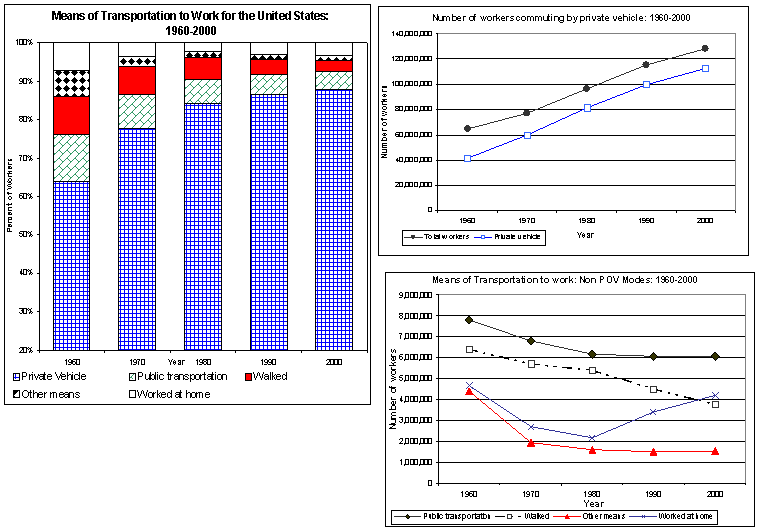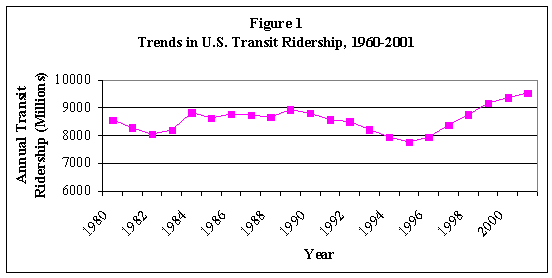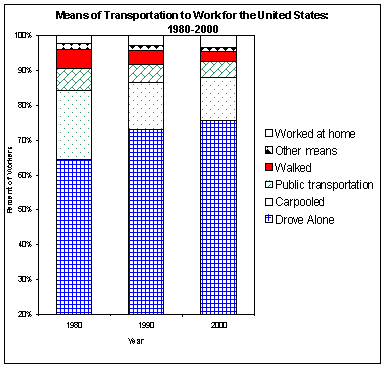Subcommittee
on Census Data for Transportation Planning
Journey to Work Trends :1960-2000
By Nanda Srinivasan, Cambridge Systematics Inc.
In the past forty years, the total number of workers reported in the
U.S. Census increased from 65 million to 128 million. Since 1980,
the number of workers who carpooled for their usual journey-to-work has
declined from 19 million to 15.6 million workers. Since 1980, number of
workers working at home increased from 2 million to 4 million workers

[Top]
CTPP Data Release Schedule
– Revised August 8, 2002
By Fabian Sanchez, U.S. Census Bureau
Prior to the CTPP2000, Summary File 3 data (Census
long form or sample data) will be released on a flow basis by state between
August and September 2002.For more information about the SF3 release and
for updates visit the following homepage: http://www.census.gov/Press-Release/www/2002/sumfile3.html.
As of August 30, 2002 the SF3 files have been released for twenty-six states.The
Census Bureau expects to release data for all the states by the end of
September 2002.
Because the CTPP2000 schedule is dependent on the
SF3 data, the schedule for the CTPP release has been revised as follows:
CTPP Part 1 – Residence Based Tables: November
2002 to January 2003
CTPP Parts 2 and 3 – Work End and Worker Flow Tables
Beginning in April 2003
[Top]
CTPP Data Access Tool Update
The contract for the CTPP
Access Tool (CAT), the interface that will be used to access the CTPP2000
data, was awarded on June 28, 2002. On July 10, 2002, the Census
Bureau conducted the kick off meeting with CENTECH, Beyond 20/20 and Digital
Engineering Corporation. CENTECH is the prime contractor, Beyond 20/20
is responsible for the tabulation interface and Digital Engineering Corporation
is responsible for generating the mapping/GIS interface.The Census Bureau
will try to have a prototype or early version of the software available
for the September TRB Conference on Transportation Planning for Small and
Medium-sized Communities in Cincinnati, Ohio.
[Top]
Transit Ridership and Transit Commuting Trends
Why Are They Different?
Chuck Purvis, Metropolitan Transportation Commission,
Oakland, California
and past chair of TRB Committee on Urban Transportation
Data & Information Systems
1. Trends in Transit Commuting
One of the more interesting results from Census 2000 is the lack of
change, at the national level, in the total number of commuters taking
public transit to work. National figures on transit commuters, excluding
taxicab commuters, is not yet available, but the data available so far
indicates no change in the number of transit commuters between 1990 and
2000. This compares to an increase of 11.5 percent in the total number
of those who work at home). These national trends mask local and regional
variation across the U.S.
Transit commute shares for the U.S.have fallen from 6.2 percent in
1980 to 4.6 percent 2000 (Table 1).The number of transit commuters has
been stable at about 6 million from 1980 to 2000.
Table 1
U.S. Transit Ridership (APTA) and Transit Commuting (Census) Trends
|
|
Transit Ridership, APTA (Millions of Boardings)
|
Transit Commuters*, Decennial Census
(# of Workers)
|
Total Commuters,
Decennial Census
(# of Workers)
|
Transit Commute Share,
Decennial Census
|
|
1980
|
8,567
|
6,007,728
|
96,617,296
|
6.2%
|
|
1990
|
8,799
|
5,890,155
|
115,070,274
|
5.1%
|
|
2000
|
9,363
|
5,873,477*
|
128,279,228
|
4.6%
|
* Transit commuters excludes
taxicab commuters. Census 2000 data on U.S. taxicab commuters is not yet
available (August 2002), and is estimated at 194,226 based on the C2SS.
Census 2000 data for U.S. public transportation commuters including taxicabs
is 6,067,703.
2 .Trends in Transit Ridership
In contrast to transit commute
statistics, data on overall transit ridership shows significantly different
patterns (Table 1). Annual transit ridership statistics compiled by the
American Public Transportation Association (APTA) show 8.6 billion annual
boardings in 1980, increasing to 8.8 billion annual boardings by 1990.
Transit ridership declined by 12 percent between 1990 and 1995, but rebounded
by 21 percent between 1995 and 2000 (Figure 1).

3. Comparing Trends in Ridership to Trends in Commuting
Comparing transit ridership (boardings) and transit
commuting (workers) shows conflicting patterns: ridership gains between
1980 to 1990, and between 1990 to 2000, but a consistent decrease in the
number of national transit commuters since 1980 (See Table 2).
Table 2:
Percent Change in Transit
Ridership and Transit Commuting
|
Year
|
Transit Ridership (Millions of Boardings)
|
Transit Commuters
(Number of Workers)
|
|
1980-90
|
+2.7%
|
-2.0%
|
|
1990-00
|
+6.4%
|
-0.3%
|
So, how can the 6.4 percent increase in national transit ridership,
1990 to 2000,
as reported by APTA, be reconciled with no change in national
transit commuting,
as derived from the 1990 and 2000 Censuses?
Several key points about transit commuting and transit
boardings need to be stated.
1. Census counts workers not trips The decennial
Census Long From is a self-reported tally of workers of how they usually
commuted from their home-to-work “last week.” A worker who uses transit
one or two days a week, will most likely choose another travel mode on
the Census questionnaire.
2. Transit boardings count each time a person boards
a transit vehicle, including transfers. These are also known
as “unlinked trips” in transit planning jargon. A “linked transit
trip” may include one or multiple boardings to go from a typical origin,
say, home, to a destination such as work. A good rule of thumb is to assume
about 1.3 boardings per linked trip. NYCTA initiated free bus/subway
transfers in 1997 which made a large difference in national counts of unlinked
trips. However, we do not have a standard measure to determine if system
design changes are increasing or decreasing the number of boardings needed
to complete one linked trip.
3. All transit trips are not commute trips.
In fact, a majority of U.S. transit trips are for non-work purposes. The
1990 National Personal Transportation Survey (NPTS) indicates that 42.6
percent of transit trips are for the purpose of “earning a living” (for
our purposes, “commute trips”); and the 1995 NPTS indicate that only 37.2
percent of transit trips are for “earning a living.”
Table 3
Estimates of Annual Work and Non-Work Transit Boardings, 1980-2000
|
|
Annual Work Boardings
|
Annual Non-Work Boardings
|
Annual
Total Boardings
|
Work Trip Share
of
Transit Boardings
|
|
1980
|
3,827
|
4,740
|
8,567
|
44.7%
|
|
1990
|
3,752
|
5,047
|
8,799
|
42.6%
|
|
2000
|
3,741
|
5,622
|
9,363
|
40.0%
|
|
% Change, 1990-00
|
-0.3%
|
11.4%
|
+6.4%
|
|
Trips are in millions. The annual work and non-work
boardings are estimates based on simple methodology of converting census
transit commuters to annual work boardings using a 637 multiplier. The
“Work Trip Share” is calculated by dividing the estimate of “Annual Work
Boardings” by APTA’s reported “Annual Total Boardings.”
4. Local Area Reconciliation of Transit Ridership and Transit Commuting
This analysis of census-based transit commuters
and total ridership statistics should also be tested at the metropolitan
and operator level, if at all possible. In addition to statistics from
the U.S. census and overall ridership data, it is best to have both on-board
transit surveys and household travel surveys to analyze changes in trip
purpose share for transit trips, and changes in transit boardings per linked
trip.
In the absence of local household travel surveys
or transit on-board surveys, data from the 2001 NHTS will be invaluable
in providing the data linkage to bridge between census and APTA ridership
statistics.
In summary, the short answer is that “yes” –increases
in transit ridership and decreases in transit commuting can be “right.”
It takes careful data analysis and an understanding that transit ridership
and transit commuting are two totally different and unique ways of examining
our transportation systems.
Additional web resources of interest:
1990 and 1995 NPTS: http://www-cta.ornl.gov/npts/
2001 NHTS: http://www.bts.gov/nhts/
APTA Ridership Statistics: http://www.apta.com/stats/ridershp/
Please Note: This article
is partially based on some of the ideas shared on the CTPP-News internet
mailing list (listserv) this past July 2002. Thanks to all in the community
for providing some great ideas.
US DOT Update on Census Issues
By Elaine Murakami, Federal Highway Administration
2000 Urbanized Area Definitions
CTPP Profile Ssheets
The first product available from the CTPP is a 2-page
profile, limited to counties (and MCD’s in selected states – Massachusetts,
Connecticut, New Hampshire, Maine, Vermont, and Rhode Island). This
2-page sheet includes 1990 and 2000 data for basic characteristics such
as household size, vehicle availability, means of transportation to work,
travel time to work and time leaving home to go to work. It also
includes 2-way cross-tabulations for: Means of Transportation to
Work by Travel Time, and Household Size by Number of Vehicles Available.
We are working with AASHTO to post the information
on their webpage. We expect the profiles to be available in October 2002.
For more information, please contact Dave Clawson at AASHTO,
davidc@aashto.orgACS Research
The NCHRP 08-48, “Using American Community
Survey for Transportation Planning” held its first meeting on August
15-16, 2002 at the new TRB facilities. The panel, chaired by Alan
Pisarski, drafted a Scope of Work, focusing on how ACS data can be used
for transportation planning and on development of a guidebook for state
DOTs and MPOs. RFP was released by NCHRP on August 27, 2002 with
responses due by October 17, 2002 (http://www4.trb.org/trb/crp.nsf/rfps).
The panel will meet on November 14-15 to select a contractor.
Other ACS research activities
at the USDOT include:
a. Seasonality research using Hampden County, MA
data, by Emily Parkany, Univ of MA.
b. Place of work coding using San Francisco, CA
data, by Deb Niemeier, UC Davis (not yet approved by CB).
c. On-site research at CB offices in Suitland, Maryland.
This research will begin with contract researchers funded by FHWA and will
then shift to BTS staff.
[Top]
CTPP Outreach Goes On Line
By Ed Christopher, Federal Highway Administration
and chair of TRB Committee on Urban Transportation
Data & Information Systems
The video, “A CTPP Day,” is now available online
at
http://mrc.fhwa.dot.gov/
and hosted by the FHWA Midwestern Resource Center.
“A CTPP Day,” in just seven minutes, presents a
light-hearted but serious look at the uses and application of the CTPP
data. While planners and users of the data will certainly relate
to the video, it was developed as a means of communicating the importance
of the CTPP to the members of the policy and technical committees involved
in regional planning processes around the country.
This video, along with printed brochures, was distributed to MPOs and
State DOTs earlier this year. One goal of these products is to assure
that technical and staff resources would be allocated to work with the
CTPP data. Our goal is to make the CTPP easy to use, but without
hardware and software for mapping, or staff to examine the data, the value
of the data will be lost. For technical issues regarding the playback
of "A CTPP Day", please contact
Clayton
Marcuson of the Miderwestern Resource Center at 708-283-3593.
To request CTPP brochures, please contact Nanda Srinivasan at 202-366-5021
or by email at
nanda.srinivasan@fhwa.dot.gov.
The CTPP Working Group is now working with a consultant
to develop a self-paced electronic guidebook. The guidebook,
when finished, will be a CD-Rom-based learning tool to assist planners
with the technical aspects and applications of the data. The electronic
guidebook is expected to be available at the beginning of 2003.
[Top]
TRB Census Subcommittee - A1D08 (a)
Message from the Chair
As many of you eagerly begin or anxiously wait to
begin analyzing the data available in SF3, care should be taken in developing
findings from the analysis. Presentation of data rests in the ability
of the analyst to “tell the story”. As the two articles in this newsletter
demonstrate, there are many pitfalls in interpreting and displaying data.
The use of percentages or absolute numbers can tell a different story to
different people. Also, there usually is a need to use other data
to support the analysis. A unique difference in most analytical work
today however is instant (sometime too!) communication with colleagues,
as evidenced by the use the CTPP listserv.
We now can begin to “tell our
story” using small area data from the SF3. To this end, the TRB Census
subcommittee has received about a dozen potential presentations for our
Poster Session at TRB in January. I hope you will have a minute to
stop by and see some of the analyses that have been done. I’m sure you’ll
walk away inspired to present in 2004. Or, if you can’t wait until
January 2004, join us at the Transportation Planning Applications Conference
in Baton Rouge (April 6-11, 2003) to share your research endeavors.
We will have a session at this conference to address current Census activities,
MPO use of census products and interaction between attendees and presenters.
Chair, TRB Subcommittee on Census Data for Transportation
Planning
[Top]



